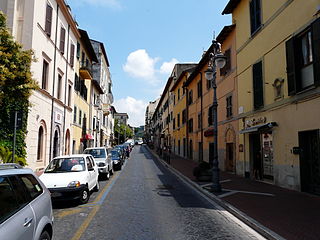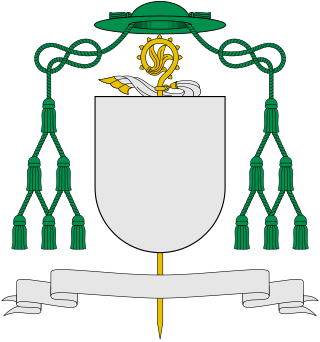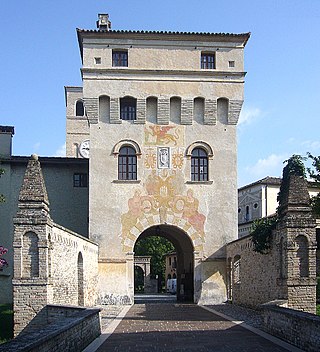
Charles Emmanuel I, known as the Great, was the Duke of Savoy and ruler of the Savoyard states from 30 August 1580 until his death almost 50 years later in 1630. He was nicknamed Testa d'feu for his rashness and military aggression.

The House of Savoy was a royal dynasty that was established in 1003 in the historical Savoy region. Through gradual expansion, the family grew in power from ruling a small Alpine county north-west of Italy to absolute rule of the Kingdom of Sicily from 1713 to 1720, when they were handed the island of Sardinia, over which they would exercise direct rule from then onward.

Pinerolo is a town and comune in the Metropolitan City of Turin, Piedmont, northwestern Italy, 10 kilometres (6.2 mi) southwest of Turin on the river Chisone. The Lemina torrent has its source at the boundary between Pinerolo and San Pietro Val di Lemina.

Grottaferrata is a small town and comune in the Metropolitan City of Rome, situated on the lower slopes of the Alban Hills, 20 kilometres south east of Rome. It has grown up around the Abbey of Santa Maria di Grottaferrata, founded in 1004. Nearby communes include Frascati, Rocca di Papa, Marino and Rome.

A territorial abbey is a particular church of the Catholic Church comprising defined territory which is not part of a diocese but surrounds an abbey or monastery whose abbot or superior functions as ordinary for all Catholics and parishes in the territory. Such an abbot is called a territorial abbot or abbot nullius diœceseos. A territorial abbot thus differs from an ordinary abbot, who exercises authority only within the monastery's walls or to monks or canons who have taken their vows there. A territorial abbot is equivalent to a diocesan bishop in Catholic canon law.

The Roman Catholic Diocese of Pinerolo is a Latin rite bishopric in the administrative province of Turin of Piedmont region, Northwestern Italy. It is a suffragan of the Metropolitan archbishopric of Turin.

Barge is a comune (municipality) in the Province of Cuneo in the Italian region Piedmont, located about 50 kilometres (31 mi) southwest of Turin and about 45 kilometres (28 mi) northwest of Cuneo. The population numbered 7,589 as of 30 November 2019.

The Italian Catholic Diocese of Ivrea is in Piedmont. For a time the diocese included the territory which had once been the diocese of Aosta, suppressed in 1803 but restored in 1817. Up until 1517 Ivrea was a suffragan of the Archdiocese of Milan; it is now a suffragan of the Archdiocese of Turin.

The Roman Catholic Diocese of Susa, in Piedmont (Italy), was established in 1772. It is a suffragan of the archdiocese of Turin. The diocese and the city of Susa lie on the main route that leads to Italy from the Mont Cenis Pass and the Col de Montgenèvre.

The Italo-Albanian Catholic Church or Italo-Albanian Byzantine-Catholic Church is one of the 23 Eastern Catholic Churches which, together with the Latin Church, compose the Catholic Church. It is an autonomous (sui juris) particular church in full communion with the Pope of Rome, directly subject to the Roman Congregation for the Oriental Churches, but which follows the Byzantine Rite, the ritual and spiritual traditions that are common in most of the Eastern Orthodox Church. It uses two liturgical languages: Koine Greek, the traditional language of the Eastern Churches, and Albanian, the native language of most of its adherents.

The 1086 papal election ended with the election of Desiderius, abbot of Monte Cassino as Pope Gregory VII's successor after a year-long period of sede vacante.

The Territorial Abbacy of Santa Maria of Grottaferrata is an ecclesiastical jurisdiction which administers the Abbey of Saint Mary in Grottaferrata located in Grottaferrata, Rome, Lazio, Italy. The Abbacy and its territory are stauropegic, that is, directly subordinate to a primate or synod, rather than to a local bishop. It is the only remnant of the once-flourishing Italo-Greek monastic tradition. It is the only monastery of the Italian Basilian Order of Grottaferrata,, a religious order of the Italo-Albanian Catholic Church. The abbot ordinary is also the superior general of the Italian Basilian Order of Grottaferrata. Though normally led by an abbot, the Abbacy has been under the authority of Bishop Marcello Semeraro since Pope Francis named him Apostolic Administrator of the Abbacy on 4 November 2013.

The Abbey of Santa Maria in Sylvis is a monastery in the centre of Sesto al Reghena, in the province of Pordenone, north-eastern Italy.
Boso was a Roman Catholic cardinal, priest of Sant'Anastasia al Palatino (1116–1122) and bishop of Turin (1122–1126×28). He was a frequent apostolic legate, making four separate trips to Spain in this capacity. In Spain he proclaimed a crusade to re-conquer the Balearics and held several synods to establish the Gregorian reforms. In Turin, he introduced the truce of God to curb private warfare.

Peter was an Italian Cistercian monk and prelate. He was the abbot of Rivalta from 1180 until 1185, abbot of Lucedio from 1185 until 1205, abbot of La Ferté from 1205 until 1206, bishop of Ivrea from 1206 until 1208 and patriarch of Antioch from 1209 until his death. He is known as Peter of Magnano, Peter of Lucedio or Peter of Ivrea.
Gerardo da Sesso was an Italian monk, bishop and cardinal of the Catholic Church.














